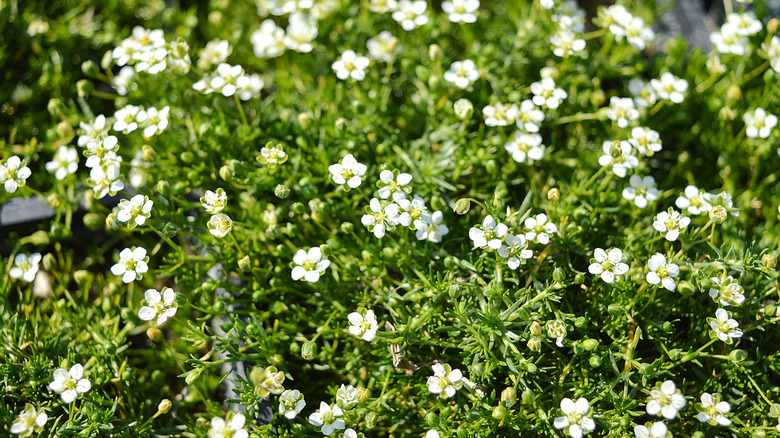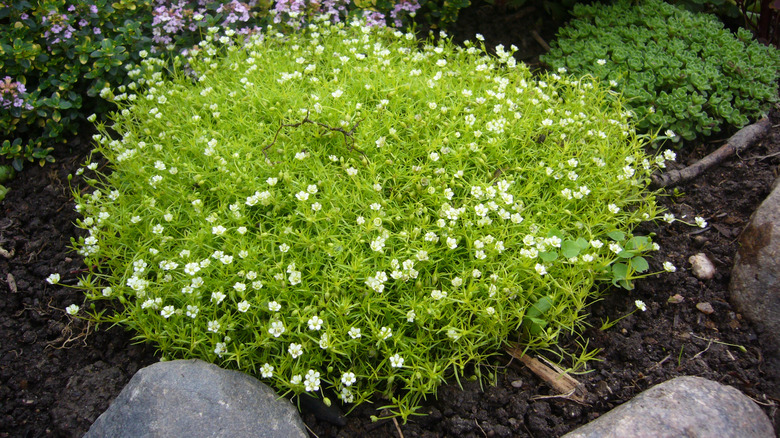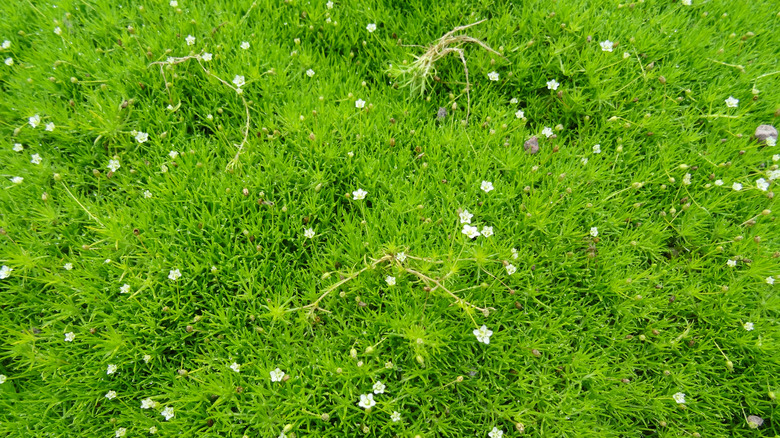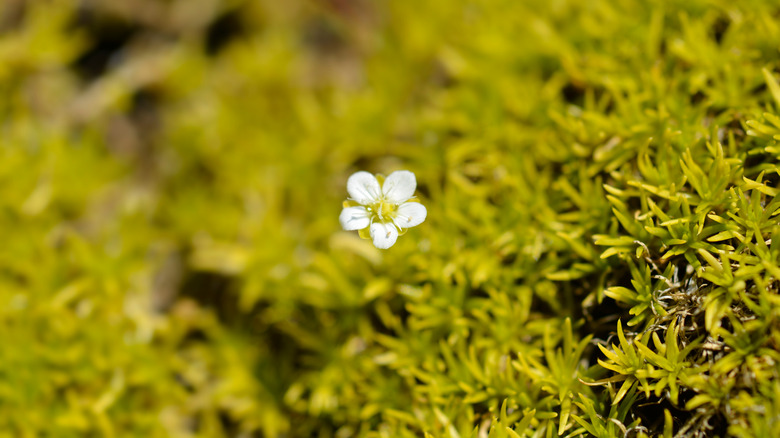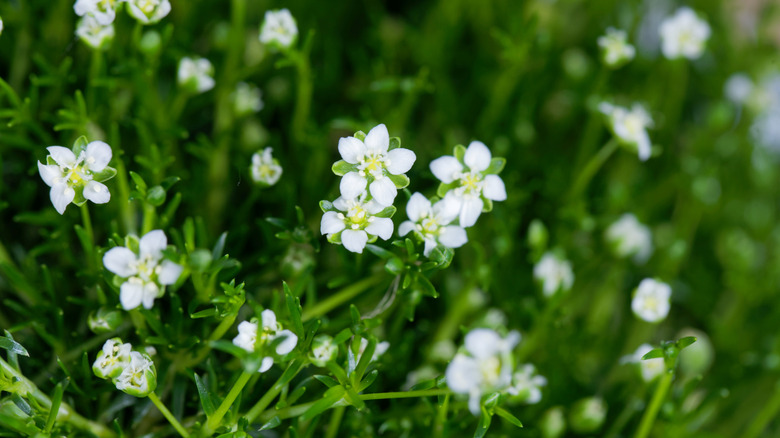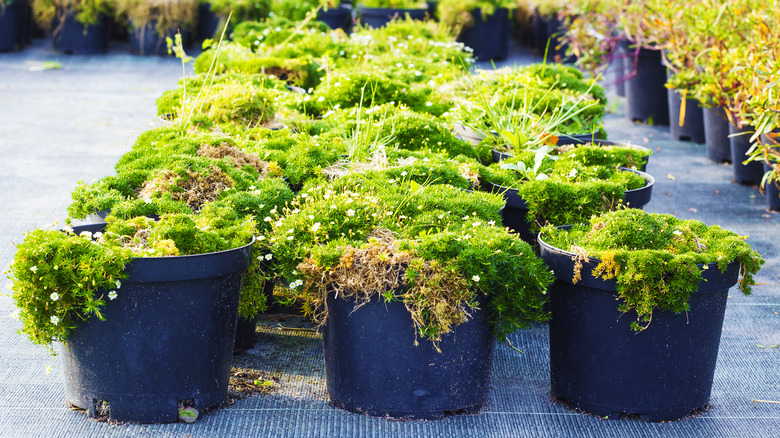How To Successfully Grow Irish Moss
Irish moss, also known as sagina subulata or heath pearlwort, is a perennial ground cover, and is actually a member of the carnation family, according to The Spruce. While the plant looks like moss, especially in large, low-to-the-ground patches, upon closer inspection you can see the individual waxy green leaves that Irish moss has. This ground cover also produces little white flowers, making it a little more romantic and delicate than actual moss.
The only thing Irish moss and actual moss have in common is the name, as sagina subulata has much different growing conditions. Moss grows in shady, moist, and acidic conditions, per The Spruce, whereas Irish moss grows in sunny, medium tempered, and alkaline to basic conditions. That being said, it is a relatively easy to grow and maintain plant, and is an excellent flowering ground cover or filler in your garden. Keep reading to learn the basics of caring for Irish moss.
How to use Irish moss in garden
Irish moss is an incredibly versatile plant, and can be used sparingly as accents in lawn design, or more heavily utilized as ground cover, and even lawn replacement. SFGate recommends replacing grass with Irish moss for a variety of reasons — if grass is too hard to grow in your area, adding both visual interest and biodiversity to your yard, cutting down on the physical labor of lawn maintenance, and even helping fight climate change. The flowering ground cover is easy to maintain once established, and will create a beautiful alternative to your average grass lawn.
That's not all Irish moss can do, though: You can use it to cover smaller and more specific areas of ground. My Garden Life recommends it for rock gardens and in front of border plants, as well as filler between paving stones. There are other plants you can plant with Irish moss for a variety of looks; Costa Farms states hostas, heucheras, and tiarellas are all great companion plants. The first two of that list will offer more green foliage for your garden with a bit of visual variety, whereas tiarellas will offer a little bit of color.
Irish moss is also a great container plant for indoors and outdoors. According to Family Handyman, Irish moss and calla lilies are a great combination, and can be grown either in ground in compatible climates, or in a container for patio decoration.
How to grow Irish moss
Growing Irish moss is quite a simple and easy task, and since these plants are perennials, planting should only need to be done once. Gardening Know How says to begin cultivating in the spring after the last threat of frost. Irish moss is most commonly planted from pre-grown plants found at nurseries or garden centers. Make sure the area you wish to plant your Irish moss in a space with either full fun or partial shade, making sure it isn't too shady as it can grow leggy, warns The Spruce. Irish moss also likes well-draining, fertile, and even sandy or loamy soil.
After the area has been prepared for planting, place the Irish moss roughly 12 inches apart. With routine care and maintenance, the plant should spread, only growing up to 2 inches in height. It will not need to be mowed, but occasionally cut any brown patches in older plants out for both plant health and aesthetic value.
How to care for Irish moss
Irish moss is a relatively low maintenance plant, perfect for use as ground cover or garden decoration. If grown outdoors, care of Irish moss will differ slightly depending on your climate. Epic Gardening suggests growing this perennial ground cover in USDA hardiness zones 4 through 8, but to be careful the warmer your climate is. For example, the plant prefers full sun, but should not be exposed to more than one hour of hot sun per day, which is more common in hotter climates. Irish moss can be grown in containers and brought inside during extreme heat if this is a concern.
Irish moss is not drought tolerant, but it also has a tendency to be waterlogged. Keep the soil consistently moist, but not overwatered. Watering the plant in the morning and letting the afternoon sun dry the excess is ideal. Irish moss can benefit from annual fertilizing with a slow-release granular fertilizer every spring. Make sure it is a low nitrogen blend, as too much nitrogen will cause the plant to grow in a mound shape rather than spread. A 5-5-5 blend is ideal, as it will stimulate flower growth while still helping maintain the shape.
Irish moss varieties
There are no other varieties of Irish moss, though there is a plant that is commonly associated with Irish moss, and some even believed it to be a variety of Irish moss. It is also a member of the caryophyllaceae, or carnation, family, and offers much of the same uses in garden design and landscaping as Irish moss. That plant is Scotch moss, or arenaria verna. Whereas Irish moss is a lush and deep green, Scotch moss is a much brighter, lemony colored green. Scotch moss also grows in flower petal, cup-like shapes, whereas Irish moss grows in short stems.
The two plants look relatively identical save for the color difference until they bloom. Irish moss blooms in small white flowers on individual stems. Scotch moss, however, grows in clusters, which will unfurl to reveal brown triangular seeds, as noted by Wisconsin Horticulture. Mature Scotch moss will also self seed through these seed clusters, which can also be easily removed to slow and contain growth. You can even intermingle both plants for what Family Handyman refers to as a mosaic effect.
Is Irish moss toxic?
There is very little information on the toxicity of Irish moss to humans, cats, or dogs. Another plant referred to as Irish moss, chondrus crispus, is well loved for its health benefits. The red algae was a favorite during the Irish potato famine, when people started eating it in an effort not to starve, as noted by Gaia Herbs.
Since there isn't much information on the carnation relative's toxicity, be careful not to mix the two up. Also, lean towards the cautious side by not ingesting the evergreen perennial, and monitor children and animals when around it.
That being said, Irish moss has been used as a dog-friendly alternative to grass; The Honest Kitchen recommends it for being non-toxic and tolerant of dogs running, munching, or digging at it. If you have a dog or outdoor cat, or have brought the plant inside, still take care to monitor your furry friend and keep Irish moss out of reach. Finally, call your vet if you suspect your pet may be experiencing poisoning symptoms, as carnations have been known to have a (albeit low) toxicity level (via Garden Guides).
How to repot Irish moss
Irish moss does not have to be restricted to your backyard or rock garden. In fact, many people prefer to pot Irish moss in containers, either to bring indoors during inclement weather, to prevent spreading, or to keep it as a houseplant. Irish moss prefers a well draining, fertile, but ultimately average potting soil, according to Garden Tabs. That being said, potted plants will not receive the same nutrients that an inground plant consistently does, so consider amending the soil with organic matter like compost, or fertilizing a little more frequently, being careful not to overwhelm the plant.
As for replanting, UK Houseplants recommends repotting Irish moss every three years. If the plant is growing too big for its pot, go up a pot size. Since Irish moss has a tendency to spread, wider and shallower pots are ideal. Simply remove the plant from its old pot, remove as much old dirt as possible from the roots, and add to the new pot with a well draining soil.
